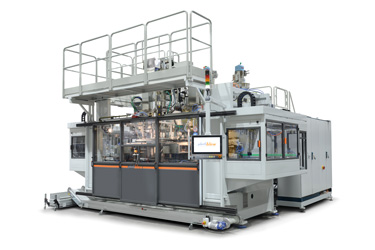 Plastiblow widens the range of its energy-efficient electric blow moulding machines by adding a new model with a 50-tons clamping unit
Plastiblow widens the range of its energy-efficient electric blow moulding machines by adding a new model with a 50-tons clamping unit
Plastiblow entered the demanding sector of industrial packaging back in 2001 with machines for the production of stackable containers, equipped with electric drives and characterized by innovative solutions and surprisingly high performances compared to the massive and energy-absorbing blow moulding machines used until then in this sector, equipped with hydraulic units, large pumps and accumulators.
On Plastiblow machines, the technology of the electric axes controlled by brushless motors, the efficient kinematics, the use of linear guides, roller bearings and kinetic energy recovery modules, allow us to achieve strong reductions in energy consumption, up to 70% lower than those of obsolete hydraulic machines.
The focus on reducing energy consumption and maintenance costs, the implementation of control systems for the remote diagnosis of processes from an Industry 4.0 perspective and, above all, the commitment to reducing environmental impact are fundamental elements of the success of Plastiblow blow moulding machines in all fields and in particular in the industrial packaging sector.
Plastiblow has long been committed to the reduction of the use of virgin plastic, and has developed multilayer coextrusion technologies capable of processing more recycled materials for the production of new containers.
The Plastiblow range includes machines for the production of industrial containers with a capacity of up to 30 litres in single and double station, for mono-layer or multi-layer containers, with standard extruders or with versions utilizing a forced feeding section for the use of high molecular weight polyethylene in granules or powders.
All Plastiblow blow moulding machines are perfectly customizable, as is normally required in a highly specialized, demanding and competent segment such as that of containers for industrial packaging.
The machines may have one or more post cooling stations, to reduce the production cycles of UN approved stackable jerry cans. It is also possible to apply static (SFDR) or dynamic (PWDS) ring extrusion equipment for thickness control and optimization of the parison radially.
For the production of containers such as shoulder pumps and pressure vessels, it is possible to use lower blowing units, with parison spreading device, and rotating blowpins for containers that require an inner thread.
Among many accessories of Plastiblow blow moulding machines, in addition to the patented system for fine tuning of the neck calibration in complete safety with the machine in running mode, there are extrusion equipment for incorporating view stripes, automatic devices for trimming and finishing, needle blowing for pinched handles, downstream units for container in-line quality control, packing units and manipulators, etc.
This year Plastiblow has already delivered, and currently has in production, several large-sized blowing machines (mod. PB22, PB26 and PB35 with horizontal shuttle strokes from 500 to 1000 mm), in single or double station models for the production of 5 & 10 litre stackable jerry cans in one, two and three cavities and 20 litres size in single or double cavities. The containers are manufactured in one, two and three-layer setup, with as many horizontal extruders as needed, and also with an additional vertical extruder for the applying the view stripe (to display the level of liquid inside the container).
At the next K 2022 exhibition in Düsseldorf, Plastiblow will be showing a brand new blow moulding machine model PB50ES-1000 Coex3 for the production of stackable 20-litre jerrycans in two cavities and in three layer configuration.
This machine is equipped with a clamping unit with a closing force of 50 tons, three high output horizontal extruders, one with a diameter of 100 mm for the middle layer and two with a diameter of 80 mm for the outer and inner layers and a double 3-layer coextrusion head with 200 mm die size and 400 mm centre distance.
The twin cavity mould has a moveable bottom section, driven by electric servomotors, and allows to reach hourly production figures of over 240 jerrycans. The new model, made for customers who have high productivity needs, is also available in a double station and double head version, with a production capacity of more than 480 pcs/h.
Thanks to the cooperation with the well-known French oil company TotalEnergies, the containers that will be produced at the exhibition in Düsseldorf will be made with a particular compound composed of recycled material (PCR) of the highest quality, odourless, colourable and with such an aesthetically pleasing structure, to be comparable to virgin HDPE material.
The choice to exhibit at K 2022 an electrically driven multi-layer coextrusion system that allows the use of recycled plastic in an intermediate layer, with minimal energy expenditure, confirms Plastiblow’s commitment to the development of a virtuous production process that is more environmentally friendly and more attentive to the enhancement of resources and the containment of waste.



